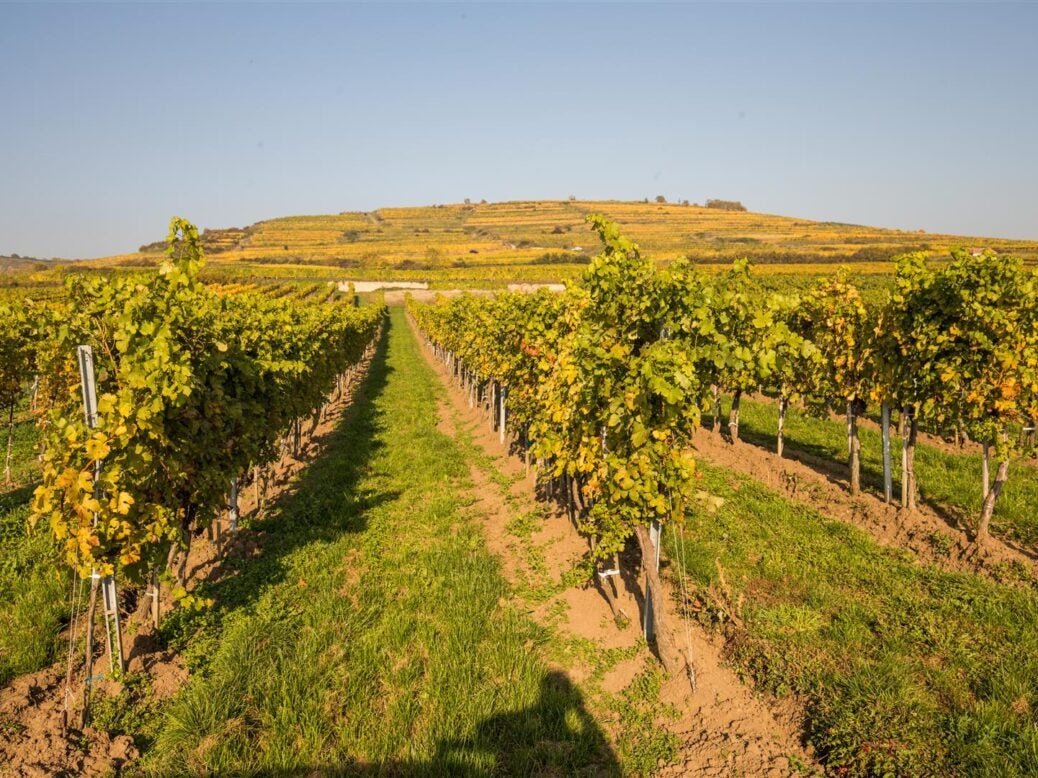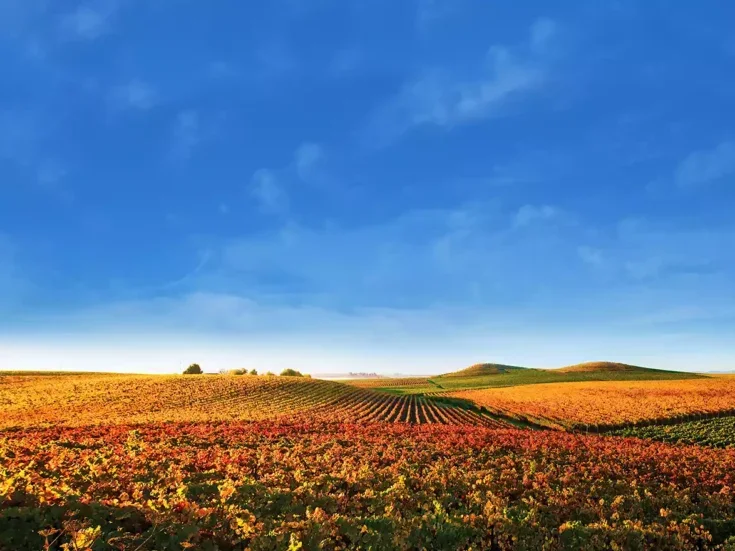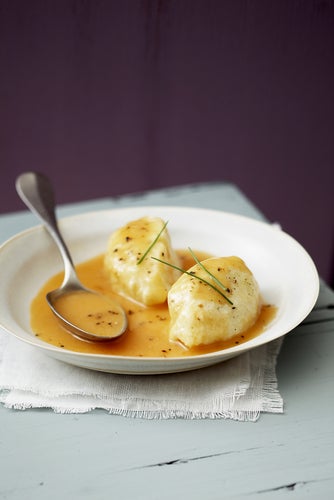
With Schloss Gobelsburg marking its 850th anniversary this year, Terry Theise spent a week tasting the great Austrian estate’s latest releases. Today, in the second installment of his three-part account of a profoundly impressive and affecting tasting, Theise presents his thoughts on Schloss Gobelsburg’s Grüner Veltliners.
You can read Theise’s review of Schloss Gobelsburg’s Zweigelt, rosé, and sparkling wines here and go to Part III, for his views on the estate’s Rieslings.
Schloss Gobelsburg’s Grüner Veltliners
It’s important to note, especially in the context of long deep tasting, that nearly every one of these GVs improved markedly over time. Bottles I emptied a week after opening were “joined” and lovely, and I questioned any doubts I was harboring. And yet, this is of limited value, because you’re not opening the bottles and drib/drabbing them out over seven days. Mostly you will open and drink, as I would. So if I tell you, the wine got better over time, that may or may not pertain to your experience. But it needs to be said. It suggests that wines that may seem asymmetrical fresh from the bottle will knit into harmony, given time. I want to be faithful to the wine as well as useful to the reader, so forgive me. I suggest you decant or otherwise aerate all these wines, as is often recommended for GV in any case.
2020 Kamptal Grüner Veltliner (Schlosskellerei Gobelsburg)
Michi writes: “We are trying to reflect the Kamp valley including (almost) all aspects of the appellation. Grapes from lower altitudes and warmer sites with higher maturity, from higher altitudes from cooler places with higher acidity and freshness, different soil, etc.”
A perfect, and I mean perfect young GV fragrance; it’s what is meant when the word “lentilly” is used, but there’s also something freshly-mown about it, a fecund green savor that suggests sweetness without sugar. It is a masterpiece of candid clarity, varietal purity, and brisk energy—brisk enough to have a little kitten-teeth on its salty finish. As a sort of tabula-rasa for the variety you could hardly ask for more.
I remember many years when I’d sit with Michi tasting this wine, my eyebrows raised as if to say Really? You’re offering this quality at this price? While he shrugged as if to say I tried to make it worse but I couldn’t.
Two days later it’s aggressively cressy and much of the ending sharpness is faded—but not all. Having tasted the sibling Riesling in the interim, I’m thinking ’20 may be better for Riesling than for GV.
2020 Langenlois | Kamptal Grüner Veltliner
Michi’s stated aim for this wine is: “We try to show the warmer aspect of the appellation. Langenlois at the lower end of the Kamptal. We are using beside others also Ried Spiegel 1ÖTW or Thal for this wine. Still it is a typical Kamptal, but showing a slightly warmer and expressive style of the appellation.”
So, A village-wine in the new system, essentially in this case a cuvée from loess.
(A quick note for completists: I am aware the estate makes many lighter wines, but I’m only commenting on the wines normally available in the US, and thus I apologize to my international readers for the lacunae herein, and to all my readers for “lacunae herein.”)
Several producers wrote to me, “You’ll like the ‘20s, Terry; they’re classical,” and with this wine I see what they mean. The wine is light-footed, forthright and salty, quite the lentilly charmer until its phenolic finish. Food will help in cases like this. And I’ll follow the wine over the coming week, alert for travel-stress, and I’ll keep it at (current) cellar temp (62ºF). Mind you, I’m not at all displeased by the wine! I’m a fussbudget for tannin/phenols and have learned to attend when my teeth yawp at me. So we’ll watch what happens.
The next day it was like Puy lentils braised in an oxtail broth. There is still a pointedness to it. The finish is deliberate and quite ferrous. I’m using a glass that generally suppresses such attributes, but they’re still present.
Now tasting for a third time—the bottle is open 72 hours. As seems to be happening generally, the “sweet” elements come forward but the gnarl on the finish never quite disappears.
2019 Ried Steinsetz | Kamptal (Grüner Veltliner)
I have put (Grüner Veltliner) in parentheses because it does not appear on the front label, and only in small print on the back. This is part of Moosbrugger’s conviction that Place should prevail over variety, a conviction I share, but only when everyone knows what the variety is. After all, it took centuries before most wine-people knew that “Meursault Charmes” was Chardonnay, and Moosbrugger seems to want to bring that about by compressing the centuries into a decade or so. I’d love it if he were right.
I’m like an old dog in my geezer years; whenever I visited the estate I always took the same seat in the tasting room, the one that looked out the window to the Steinsetz. Briefly, it’s (Danube) river rocks deposited by the retreating river, overlain by loess. But perhaps more saliently, it’s a breezy plateau that can be picked late with little concern for botrytis. Always a particular GV, in its young days it was a radishy beast, but it grew deeper as the vine roots sank deeper, and these days it’s a 1er Cru with a curiously adamant brassy profile mitigated by ever more prominent juiciness.
I have it in two glasses, one that will emphasize the peppery sting and another that will subdue it. The emphatic glass tells the Truth about the wine while the other glass tells a more pleasing version of the truth. That one—the tall Spiegelau white wine stem, brings out a lovely note of cordyceps. I know, WTF are they?!? It’s an edible fungus that’s incredibly good for you, and the purest way to encounter it is in its dried form, which you can obtain from Far West Fungi. The liquid you get from soaking your cordyceps is culinarily precious; you can make a really haunting risotto with it. You’ll also find it in tinctures and suchlike, if you have money to burn.
Back to Steinsetz!
I think we ought to decant Steinsetz, just observing what happens as it gains air. Instead, I’ll leave it in the cellar and taste it repeatedly. There’s a lot to marvel over in here, and I want to see if it gets more swoony in the next bunch of days. The unfolding aroma suggests that it will.
OK, two updates. At the dinner table last night the wine was pungently exotic and tasty, so it tastes one way and drinks another. But tasted again the following day it feels like it has more muscle than it is currently managing. Perhaps this has been exposed by the developmental stage it’s in – or it’s travel sick. There are many compelling things about this wine, but its components aren’t interlocked, at least not here or now. Yet every third sip is so good I feel like a fool, to cavil as I’m doing. Something tells me the wine will have the last laugh. But until then, I’m bemused by the scorched-pepper finish.
2019 Ried Renner | 1ÖTW | Kamptal (Grüner Veltliner) ++
(With the symbol for Grand Cru next to the site name.)
Here’s an oddity. This bottle and the Steinsetz before it each had a curious smell of maple-syrup on the lip as I was pulling the cork, suggesting some tiny residue of goo that usually means the bottle was heated at some point.
So, OK, Renner. My favorite. Has been since forever. For me this is one of the great GVs anywhere, and one with very few equivalents. Steinertal comes to mind (thanks to Alzinger) but even those gorgeous wines don’t quite reach the polyphonic heights of this one. My inconvenient opinion is, the great GV masterpiece of Schloss Gobelsburg is Renner—even more than Lamm. “Inconvenient” because Lamm is the Chambertin of the Kamptal, and if you have it, it’s your top GV—understood. (And quite often justified.)
I have written (and written) about this in catalogue after catalogue, and the flavor associations for this wine would fill your biggest suitcase. Let me try to squeeze it down. Renner is GV for people who love Riesling. It’s GV that lived amongst the Rieslings and went home speaking with a Riesling brogue. It has buoyancy, lift, and minerality, and that curious sense of “sweetness” that isn’t sugar, but culmination.
I fantasize about a composer who thinks “I’m going to write a triple fugue, but instead of Bach’s divine mathematics I’m gonna do it full-bore romantic, and we’ll see if intricacy and sentiment can coexist!”
Because Renner will tax you, ecstatically, but demandingly. Everything about it is beautiful but nothing about it is easy. Renner is a rapture, but it isn’t necessarily sublime. This vintage has some of the assertiveness of Lamm, actually, along with its insane minerality and rampant sweet-corn flavors. Don’t get me wrong, I’m blown away by it. But I have a subversive thought….
The vintage was identified as great based on tastings a year ago. I know those tastings; the wines are blasting with primary fruit and psychedelic complexity and of course they’re great. But I’m seeing the wines a year later. Some might say, at the “worst” time. I’d simply observe, I’m seeing a lot of muscle now, which can be good if there’s mind and kindness behind it. Still, that argument probably doesn’t belong with this wine, because this wine is stunning by any reckoning.
2018 Ried Lamm | 1ÖTW | Kamptal (Grüner Veltliner) ++
(Grand Cru) And I applaud the estate for giving this an extra year of aging pre-release. This is sometimes a silver-lining of the pandemic.
Lamm is both a mystery and a simplicity. It is large. In Bründlmayer’s hands it makes a mighty wine that’s as graceful (and as sweet) as an elephant. Moosbrugger’s wines are taller, stretch-ier. Giraffes, basketball players. Great, they assuredly are. But great in what way, exactly?
MacNeil’s “creamy and silky” glass does its job exactly—it makes the wine creamy and silky. It emphasizes the darker spectrum of the aromas. It also highlights the wood.
The Spiegelau “tall” glass—usually perfect for a wine like this—throws every bright aroma the wine displays right into your face. It’s enormously satisfying and impressive.
The Jancis glass tells you that a possibly-great wine is at hand. Every scintilla of nuance is on full display. Sometimes this glass seems to say “Now let me explain…” but this time it let me see a kind of yielding quality I might have missed.
Lamm, when it works (which is almost always), is intense without being musclebound. Its signatures have been explicated often in my catalogues, but essentially it’s rusks, fennel seed, grass-fed lamb, toasted rye, a bit of the “wet-cereal” thing we get from loess. It’s intensely savory. And incidentally, in Gobelsburg’s hands it is an object-lesson on the proper use of cask. And this wine is an unlikely mingling of detail and succulence.
Austrian wine close-observers may consider, Lamm has a cousin in Achleiten, while Renner’s cousin is Schütt. I know—inside-baseball. But interesting for all that, for minds like mine that like to catalogue.
For those who may want to contemplate a (probably) great Austrian white wine that’s as far from the “grape variety” as possible—even while the grape is always present—this is where I’d send you. For me, as a long-time observer, I find this 2018 Lamm to be entirely lovely. It could be the best since the 2013. It has authority and intrigue. It takes you into a sweet, sweet field. If you’ll let me be totally crazy, it’s like grass-fed lobster—if that could ever be!
A note on scores by Terry Theise
I disapprove of points. I don’t recognize measuring wines against a notion of “perfection,” I think it’s a fool’s errand to assign absolute value to an ephemeral impression, and the more precise a scoring system purports to be, the more it actually misleads.
That said, my mind forms hierarchies of its own volition, and special wines warrant special attention. So I’ll revert to my deliberately inexact system of plusses—one, two, or three—to recognize the most remarkable wines. My plusses are sort of like Michelin stars. One plus is a wine that stood out. Two plusses is a wine that made me stop and consider the depth of its beauty. Three plusses is a wine that tingles with greatness, and offers a moment of profundity. Feel free to superimpose whatever scoring system you deploy; the point-systems are harmful but the folks who use them aren’t evil, so if you want to conflate my three plusses with a scoring range that makes sense to you, be my guest.
Extracted with permission from Terry Theise’s Tasting Protocols.






